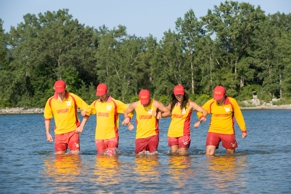National Lifeguard certification is Canada's professional
lifeguard standard and is designed for lifesavers who wish to
obtain a responsible job and leadership experience. Successful
candidates are certified by the Lifesaving Society - Canada's
lifeguarding experts.
National Lifeguard - Waterfront certification
is designed to develop the fundamental values, judgment, knowledge,
skills and fitness required by lifeguards. The National Lifeguard
course emphasizes the lifeguarding skills, principles and
practices, and the decision-making processes that will assist the
lifeguard to provide effective safety supervision in waterfront
environments.
Prerequisites: Minimum 15 years of age. Bronze Cross
certification and Lifesaving Society Standard First Aid (need not be
current) or SFA from one of
these approved agencies.
:::

Instruction and certification: Current National
Lifeguard Instructors (who hold National Lifeguard Waterfront)
teach and evaluate most items, but only National Lifeguard
Examiners (who hold National Lifeguard Waterfront) may certify
candidates. The Lifesaving Society deems its certifications to be
"current" for 24 months from the certification date.
Candidate recognition: National Lifeguard
certification card.
Required reference material:
Alert.
At-A-glance
Test Items
- *Lifeguarding theory and practice: Demonstrate
knowledge of the principles and techniques of lifeguarding included
in the National Lifeguard test items, and answer questions drawn
from the Canadian Lifesaving Manual (CLM) and Alert:
Lifeguarding in Action
- *Waterfront facility analysis: Demonstrate an
understanding of:
- Features that vary from waterfront to waterfront (or from time
to time) and how analysis of these affects lifeguarding
- Enviromental hazards of waterfronts
- *Rescue aid proficiency: Demonstrate
proficiency in the use of buoyant and non-buoyant rescue aids
appropriate for a variety of victim types in supervised waterfront
environments.
- *Entries and removals: Demonstrate three
entries and three removals appropriate for a waterfront
enviroment.
- *Skin diving skills: Demonstrate skin diving
skills: Wearing mask, fins and snorkel, swim 5 metres at the
surface; head-first surface dive and swim 15 metres underwater;
surface, purge snorkel and swim 5 metres at the surface.
- *Rescue drill: Demonstrate rescue skills using
equipment: Approach 5 metres on the beach with a rescue aid and
fins; enter the water, don fins; swim 50 metres
- *† Use of rescue craft: Demonstrate effective
use of a rescue board or rescue craft: Approach 5 metres on the
beach; enter the water with a rescue craft; pick up a victim 100
metres away and return to shore.
- Physical standards
- *† Sprint challenge: Demonstrate anaerobic
fitness: Starting in the water, swim 50 metres within 60 seconds
(50 yd. within 55 seconds).
- *† Endurance challenge: Demonstrate aerobic
fitness and endurance: Swim 400 metres within 10 minutes.
- *Lifeguard communication: Demonstrate
effective communication with patrons, victims, other lifeguards,
supervisors and emergency service personnel.
- Supervision
- *Position and rotation: Demonstrate effective
waterfront supervision using lifeguard positioning and
rotation.
- *† Scanning and observation: Demonstrate
effective lifeguard scanning techniques and observation skills in
the waterfront environment.
- *Prevention and intervention: Demonstrate an
ability to recognize situations in which early lifeguard
intervention may prevent a rescue emergency.
:::
- *Missing person: Demonstrate an effective
search of the waterfront for a missing person as both a member and
a leader of a lifeguard team.
- Victim management
- *† Management of distressed or drowning
victim: Demonstrate effective management of a distressed
or drowning victim in deep water: Run 100 metres with a rescue aid;
enter water and swim 100 metres to recover a conscious victim; tow
or carry the victim 100 m; provide appropriate follow-up
treatment.
- *† Management of submerged, non-breathing
victim: Demonstrate effective management of a submerged,
non-breathing victim and perform 10 cycles of 2 ventilations:30
compressions on a CPR manikin.
- *Management of spinal injured victims: With
the assistance of one back-up lifeguard or assistant lifeguard and
one bystander, demonstrate effective management of suspected
spinal-injured victims (breathing and non-breathing) found in the
water
- *† Management of an injured victim:
Demonstrate effective management of an injured victim on land or in
the water.
- Lifeguard situations
- † Single lifeguard situation: As a single
lifeguard, respond to a situation in a supervised aquatic setting
with one auxiliary staff member.
- † Lifeguard team situations: As a member of a
lifeguard team, respond to situations in a supervised aquatic
setting.
*Asterisk indicates instructor-evaluated item. The † symbol
denotes the only items evaluated during a recertification.